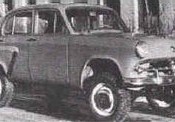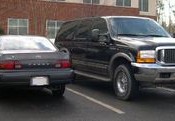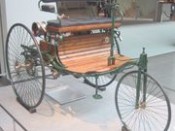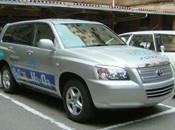Sport Utility Vehicle (SUV)
A sport utility vehicle, or SUV, is a type of passenger vehicle which combines the load-hauling and versatility of a pickup truck with the passenger-carrying space of a van or station wagon. Most SUVs are designed with a roughly square cross-section, an engine compartment, a combined passenger and cargo compartment, and no dedicated trunk. Most mid-size and full-size SUVs have 5 or more seats, and a cargo area directly behind the last row of seats. Mini SUVs, such as the Jeep Wrangler, may have fewer seats.
It is known in some countries as an off-roader or four wheel drive, often abbreviated to 4WD or 4×4, and pronounced “four-by-four”. More recently, SUVs designed primarily for driving on roads have grown in popularity. A new category, the crossover SUV uses car components for lighter weight and better fuel economy.
Contents
- Sport Utility Vehicle Design Characteristics
- Sport Utility Vehicle History
- SUVs in Remote Areas
- Other Sport Utility Vehicle Names
- Sport Utility Vehicle Criticism
Sport Utility Vehicle Design Characteristics
SUVs were traditionally derived from light truck platforms, but several SUVs and crossover SUVs are based on platforms of unibody construction.
SUVs typically have high seating and most can be equipped with four wheel drive, providing an advantage in low traction environments. The design also allows for a large engine compartment, which allows for a wide variety of engine choices, both gasoline and diesel.
Sport Utility Vehicle History
Sport utility vehicles were originally descended from commercial and military vehicles such as the Jeep and Land Rover. SUVs have been popular for many years with rural buyers due to their off-road capabilities. The Jeep Wagoneer and the Ford Bronco were early SUV examples, followed by the Chevrolet Blazer and the GMC Jimmy. International Harvester also sold SUV’s, notably the three-door International Scout and the five-door International Travelall.
In the last 25 years, and even more in the last decade, SUVs have become popular with urban buyers. Consequently, more modern SUVs often come with more luxury features and some crossover SUVs, such as the BMW X5, the Acura MDX, and the Toyota RAV4, have adopted lower ride heights and utilize unibody construction to better accommodate their use for on-road driving.
Sport Utility Vehicle Popularity
SUVs became popular in the United States, Canada, and Australia in the 1990s and early 2000s for a variety of reasons. Buyers became drawn to their large cabins, higher ride height, and perceived safety when in the market for a new vehicle. Additionally, most full-size SUVs have far greater towing capacities than conventional cars, allowing owners to tow RVs, trailers, and boats with relative ease, adding to the utilitarian image.
A large growth in SUV popularity and sales is due to advertisement targeted towards women. Women constitute more than half of SUV drivers, and SUVs are the most popular vehicle choice of women in the United States.
The most common reason for SUV popularity cited by owners was their perceived safety advantage in a collision with regular cars, though the rollover fatality risk is much higher in SUVs than cars. Some of their success could also be attributed to their “utilitarian” image. In the late 1990s and early 2000s, vehicle manufacturers sold SUVs very effectively, with per-vehicle profits substantially higher than other automobiles. Historically, their simpler designs often made the vehicles cheaper to make than comparably-priced cars.
In the mid 2000s, however, their popularity has waned, due to higher gasoline prices, rollover accident fatalities and higher relative pollution. As of the spring of 2006, some of the larger SUVs now require over $100.00 per fillup, making thier everyday use more cost-prohibitive. Current model SUVs (crossovers) take into account that 98% of SUV owners never offroad. As such, SUVs now have lower ground clearance and suspension designed primarily for paved road usage.
SUVs in Remote Areas
SUVs are often used in places such as the Australian Outback, Africa, the Middle East, Alaska, Northern Canada and most of Asia, which have limited paved roads and require the vehicle to have all-terrain handling, increased range, and storage capacity. The low availablity of spare parts and the need to carry out repairs quickly allow model vehicles with the bare minimum of electric and hydraulic systems to predominate. Typical examples are the Land Rover, the Toyota Land Cruiser and the Lada Niva.
SUVs targeted for use in civilization have traditionally originated from their more rugged all-terrain counterparts. For example the Hummer H1 is derived from the HMMWV, originally developed for the US Armed Forces.
Other Sport Utility Vehicle Names
Outside of North America and India, these vehicles are known simply as four-wheel-drives, often abbreviated to “4WD” or “4×4”. They are classified as cars in countries such as the UK where the U.S. distinction between cars and ‘light trucks’ is not used. In Australia, the automotive industry and press have recently adopted the term SUV in place of four wheel drive in the description of vehicles and market segments. “Utility” or “ute” refers to an automobile with a flatbed rear or pick-up, typically seating two passengers and is often used by tradesmen, and is typically not a 4WD vehicle.
Sport Utility Vehicle Criticism
The explosive growth in SUV ownership has attracted a large amount of criticism, mainly of the risks to other road users and the environment, but also on the basis that the perceived benefits to the vehicle owner are illusory or exaggerated.
Sport Utility Vehicle Safety
Safety is a common point of criticism. The majority of modern automobiles are constructed by a method called monocoque or unibody construction, whereby a steel body shell absorbs the impacts of collisions in crumple zones. However, many SUVs are constructed in the body-on-frame style of light trucks, which can lead to a lower level of safety when not designed well. Often, their heavier weight, height, and stiffer construction (due to body-on-frame design) hurts other drivers and pedestrians, while their higher center of gravity increases the risk of death for the SUV passengers from rollover.
However, some SUVs have designs based on unibody construction, including the Ford Escape/Mazda Tribute, Lexus RX 330 and RX 400h, Hyundai Santa Fe, Lada Niva, and Acura MDX. The Jeep Cherokee/Liberty (1984 on) and Grand Cherokee (1993 on) have even used unibody construction from their beginning.
Sport Utility Vehicle Risk to Other Drivers
Because of SUVs’ greater height and weight, and often usage of body-on-frame constructions, it is documented that many SUVs hurt public road safety by increasing risk for people both inside and outside the SUV (in other vehicles or on foot). This is due to the SUVs’ weight and height advantage in multi-vehicle accidents (resulting in much fewer deaths in the vehicle, but increasing risks for others) being counterbalanced by their raised center of gravity.
In 2004, the National Highway Traffic Safety Administration released figures showing that drivers of SUVs were 11% more likely to die in an accident than people in cars. These figures may be confounded by variables other than the vehicles’ inherent safety, for example the documented tendency for SUVs to be driven more recklessly (most sensationally perhaps, the 1996 finding that SUV drivers are more likely to drive drunk). SUV drivers are also statistically less likely to wear their seatbelts.
The considerable weight of full-size SUVs (such as the Chevrolet Suburban and the Ford Excursion) makes collisions with other, smaller cars much less dangerous for the SUV and much more dangerous for the car. The higher ride and other design characteristics of many SUVs may also lead to greater damage to smaller crash partner cars. These mass and design dangers are known as crash incompatibility issues in the crash testing industry, and are a topic of active research. The most notable statistic in SUV design crash incompatibility is an increase in fatalities when an SUV strikes the head of a passenger or driver in a side-impact collision. This is one of the motivations for the development of side-curtain airbags in standard autos.
The high center of gravity of SUVs makes them more prone to rollover accidents (especially if the vehicle leaves the road or in emergency maneuvers) than lower vehicles. In recent years, Consumer Reports has found a few SUVs unacceptable due to their rollover risk. Modern SUVs are usually designed to prevent rollovers on flat surfaces.
Average heights for:
- Family sedans 57.3 inches
- Minivans 70.2 inches
- SUVs 70.7 inches
SUV safety concerns are compounded by a perception among some consumers that SUVs are safer for their drivers than standard autos. According to G. C. Rapaille, a psychological consultant to automakers (as cited in Gladwell, 2004), many consumers feel safer in SUVs simply because their ride height makes “[their passengers] higher and dominate and look down (sic). That you can look down [on other people] is psychologically a very powerful notion.” This and the massive size and weight of SUVs may lead to consumers’ false perception of safety (Gladwell, 2004).
In Europe, effective 2006, the fitting of bull bars, also known as grill guards to vehicles such as 4x4s and SUVs is illegal.
Sport Utility Vehicle Risk to Pedestrians
An SUV hitting a pedestrian is about twice as likely to kill as a car at equal speed. This is in part because the collision of an SUV with a pedestrian tends to impact the chest, while the collision of a car with a pedestrian tends to impact the knees. This data is however primarily for the American market, where SUVs are ladder-framed-chassis vehicles (like the Lincoln Navigator or Chevrolet Tahoe), and should not necessarily be applied to modern crossovers, like the BMW X5, Volkswagen Touareg or even the Range Rover, as these cars (and many other modern crossovers) are monocoques, and have no chassis.
The size and design of the SUVs leads to a restricted driver’s view of the area immediately surrounding the vehicle. The back view is particularly restricted. Quite a few manufacturers try to remedy the problem by offering rear-view cameras or simple sensors that sound the alarm if the car is about to hit something. This is still rather new technology and is not fool-proof. Aftermarket offerings also exist for interested buyers.
Recent Sport Utility Vehicle Improvements
Manufacturers have added car-level bumpers to reduce the possibility of the other vehicle(s) sliding under the SUV in a collision. SUV’s have therefore become somewhat safer for other road users in recent years.
Sport Utility Vehicle Fuel Economy
The recent popularity of SUVs is one reason the U.S. population consumes more gasoline than in previous years. SUVs are as a class much less fuel efficient than comparable passenger vehicles. The main reason is that SUVs are classified by the U.S. government as light trucks, and thus are subject to the less strict light truck standard under the Corporate Average Fuel Economy (CAFE) regulations. The CAFE requirement for light trucks is an average of 20.7 mpg (US), versus 27.5 mpg (US) for passenger cars (8.6 and 11.4 km/L, respectively).
As there is little incentive to change the design, SUVs have numerous fuel-inefficient features. The high profile of SUVs increases wind resistance. Heavier suspensions and larger engines increase vehicle weight. Some SUVs also often come with tires designed for off-road traction rather than low rolling resistance.
Addressing fuel efficiency, several manufacturers now offer hybrid gas/electric models of SUVs, offering improved fuel economy over conventionally powered SUVs. With some hybrid SUV models, the added power generated from the hybrid systems is used some times to give vehicles added performance (increased power).
A point which is not covered in most fuel calculations is the air conditioning. The increased wind screen surface for the larger vehicles leads to much higher energy demand for cooling in summer or in hot climates. So fuel consumption in real time operation will be much higher than specified.
Sport Utility Vehicle Pollution
Because SUVs typically use much more fuel than cars, they generate much higher volumes of pollutants (particularly carbon dioxide) into the atmosphere, thus leading to higher levels of global warming. In the U.S., light trucks and SUVs are held to a less-strict pollution control standard than are passenger cars. Intense political lobbying from the auto industry has served to maintain the relatively poor SUV mileage and pollution control standards.
However, compact SUVs like the Toyota Rav-4 and Honda CR-V are offered with diesel engines in Europe, and with these fitted can have considerably lower emissions than many cars. An example would be the Toyota Rav-4 2.2d (140 bhp) that has carbon dioxide emissions of 173g/km, compared to a Mercedes A-class 2.0T, with carbon dioxide emissions of 192g/km. These figures contrast with many people’s view that SUVs are worse for the environment, as the A-class (a definitive city car) has higher emissions (and therefore contributes more to climate change) than the Rav-4, a supposedly polluting SUV.
Sport Utility Vehicle Slang
In southern England, SUVs are often referred to in derogatory terms as “soft roaders” or “Chelsea tractors”, due to their popularity among affluent people living in central London areas such as Chelsea. In the UK they are occasionally known as jeeps or Land Rovers no matter what make they actually are, although the increasing prevalence of these vehicles in recent years has decreased this colloquial usage. In New Zealand they are occasionally called “Fendalton tractors” or “Remuera tractors” after the higher priced suburbs in Christchurch and Auckland respectively. In Australia, Victoria, they are sometimes referred to as “Toorak Tractors”, though this is rare. In Norway, they are known as ‘bourse tractors’ due to yuppie stereotypes. In The Netherlands they are often called “PC Hooft-tractoren” after Amsterdam’s most exclusive shopping street. SUVs are also criticized in the Netherlands for similar reasons, and some environmentalists are pushing local governments to deny SUV users parking spaces.







